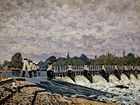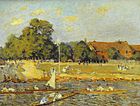| Revision as of 03:32, 18 April 2011 editLockley (talk | contribs)Autopatrolled, Extended confirmed users136,540 editsm →External links: narrow cat← Previous edit | Revision as of 15:05, 17 May 2011 edit undo68.99.152.14 (talk)No edit summaryNext edit → | ||
| Line 101: | Line 101: | ||
| {{Reflist|2}} | {{Reflist|2}} | ||
| ⚫ | nch artists''. Grove Art. New York: St Martin's Press. ISBN 0-312-22971-2 | ||
| ==References== | |||
| *Denvir, B. (2000). ''The Chronicle of Impressionism: An Intimate DIary of the Lives and World of the Great Artists''. London: Thames & Hudson. OCLC 43339405 | |||
| *Poulet, A. L., & Murphy, A. R. (1979). ''Corot to Braque: French Paintings from the Museum of Fine Arts, Boston''. Boston: The Museum. ISBN 0-87846-134-5 | |||
| *Reed, Nicholas, (2008). ''Sisley on the Thames and the Welsh Coast''. Lilburne Press. ISBN 978-1-901167-20-7 | |||
| *Rosenblum, Robert (1989). ''Paintings in the Musée d'Orsay''. New York: Stewart, Tabori & Chang. ISBN 1-55670-099-7 | |||
| ⚫ | |||
| ==External links== | ==External links== | ||
Revision as of 15:05, 17 May 2011
| Alfred Sisley | |
|---|---|
 Alfred Sisley in 1882 Alfred Sisley in 1882 | |
| Nationality | British |
| Education | Marc-Charles-Gabriel Gleyre |
| Known for | Painting |
| Movement | Impressionism |
Alfred Sisley (30 October 1839 – 29 January 1899) was an French-born English Impressionist landscape painter who was born, and spent most of his life, in France. Sisley is generally recognized as the most consistent of the Impressionists in his dedication to painting landscape en plein air (i.e., outdoors). He never deviated into figure painting and, unlike Renoir and Pissarro, never found that Impressionism did not fulfill his artistic needs.
Among his most important works are a series of paintings of the River Thames, mostly around Hampton, executed in 1874, and various landscapes depicting places in or near Moret-sur-Loing.
Biography
Sisley was born in Paris to affluent English parents. His father William Sisley was in the silk business, and his mother Felicia Sell was a cultivated music connoisseur. In 1857, at the age of 18, Sisley was sent to London to study for a career in business, but he abandoned it after four years and returned to Paris in 1861. Beginning in 1862 he studied at the Paris École des Beaux-Arts within the atelier of Swiss artist Marc-Charles-Gabriel Gleyre, where he became acquainted with Frédéric Bazille, Claude Monet, and Pierre-Auguste Renoir. Together they would paint landscapes en plein air rather than in the studio, in order to realistically capture the transient effects of sunlight. This approach, innovative at the time, resulted in paintings more colorful and more broadly painted than the public was accustomed to seeing. Consequently, Sisley and his friends initially had few opportunities to exhibit or sell their work. Their works were usually rejected by the jury of the most important art exhibition in France, the annual Salon. During the 1860s, though, Sisley was in a better position than some of his fellow artists, for he received an allowance from his father.
In 1866 Sisley began a relationship with Eugénie Lesouezec (1834–1898; also known as Marie Lescouezec), a Breton living in Paris. The couple produced two children: son Pierre (born 1867) and daughter Jeanne (1869). At the time, Sisley lived not far from Avenue de Clichy and the Café Guerbois, the gathering place of many Parisian painters. In 1868 his paintings were accepted at the Salon, but the exhibition did not bring him any financial or critical success, and neither did any of the subsequent exhibitions.

The Franco-Prussian War began in 1870, and as a result, Sisley's father's business failed. The painter's sole means of support became the sale of his works. For the remainder of his life, he would live in poverty, for his paintings only rose significantly in monetary value after his death. Occasionally, however, Sisley would be backed up by his patrons: this allowed him, among other things, to make a few brief trips to England. The first of these occurred in 1874 after the first independent Impressionist exhibition. The result of a few months spent near London was a series of nearly twenty paintings of the Upper Thames near Molesey, which was later described by art historian Kenneth Clark as "a perfect moment of Impressionism."
Until 1880, Sisley lived and worked in the countryside west of Paris; then Sisley and his family moved to a small village near Moret-sur-Loing, close to the forest of Fontainebleau where the painters of the Barbizon school had worked earlier in the century. Here, as art historian Anne Poulet has said, "the gentle landscapes with their constantly changing atmosphere were perfectly attuned to his talents. Unlike Monet, he never sought the drama of the rampaging ocean or the brilliantly colored scenery of the Côte d'Azur." In 1881 Sisley made one more brief voyage to England.
In 1897 Sisley and his partner visited Wales and were finally married in Cardiff Register Office on 5 August. They stayed at Penarth, where he painted at least six oils of the sea and the cliffs. In mid-August they moved to the Osborne Hotel on the Gower Peninsula, where he produced at least eleven oil-paintings in and around Rotherslade Bay. They returned to France in October. This was Sisley's last voyage to his ancestral homeland, and the National Museum of Wales in Cardiff now possesses two of his Welsh oilpaintings.
The following year he applied for French citizenship but was refused; a second application was made and supported by a police report, however illness intervened, with Sisley remaining English till his death. The painter died in Moret-sur-Loing at the age of 59, just a few months after the death of his wife.
Work

Sisley's student works are lost. His earliest known work, Lane near a Small Town, is believed to have been painted around 1864. His first landscape paintings are sombre, coloured with dark browns, greens, and pale blues. They were often executed at Marly and Saint-Cloud. Little is known about Sisley's relationship with the paintings of J. M. W. Turner and John Constable, which he may possibly have seen in London, although these artists have been suggested as an influence on his development as an Impressionist painter, as have Gustave Courbet and Jean-Baptiste-Camille Corot.
Among the Impressionists Sisley has been overshadowed by Monet, although his work most resembles that of Camille Pissarro. Described by art historian Robert Rosenblum as having "almost a generic character, an impersonal textbook idea of a perfect Impressionist painting", his work strongly invokes atmosphere and his skies are always very impressive. His concentration on landscape subjects was the most consistent of any of the Impressionists.
Among Sisley's best-known works are Street in Moret and Sand Heaps, both owned by the Art Institute of Chicago, and The Bridge at Moret-sur-Loing shown at Musée d'Orsay, Paris. Allée des peupliers de Moret (The Lane of Poplars at Moret) has been stolen three times from the Musée des Beaux-Arts in Nice. Once in 1978 when on loan in Marseille (recovered a few days later in the city's sewers), again in 1998 (in which the museum's curator was convicted of the theft and jailed for five years along with two accomplices) and finally in August 2007. On 4 June 2008, the French National Police recovered it and three other stolen paintings from inside a van in Marseilles.
Selected works

- Lane near a Small Town (c. 1864)
- Avenue of Chestnut Trees near La Celle-Saint-Cloud (c. 1865)
- Village Street in Marlotte (1866)
- Avenue of Chestnut Trees near La Celle-Saint-Cloud (1867)
- Still Life with Heron (1867)
- The Seine at St. Mammes (1867–69)
- View of Montmartre from the cite des Fleurs (1869)
- Early Snow at Louveciennes (c. 1871–72)
- Boulevard Heloise, Argenteuil (1872)
- Bridge at Villeneuve-la-Garenne (1872)
- Ferry to the Ile-de-la-Loge - Flood (1872)
- Footbridge at Argenteuil (1872)
- La Grande-Rue, Argenteuil (c. 1872)
- Square in Argenteuil (Rue de la Chaussee) (1872)
- Chemin de la Machine Louveciennes (1873)
- Factory in the Flood, Bougival (1873)
- Rue de la Princesse, Louveciennes (1873)
- Sentier de la Mi-cote, Louveciennes (1873)
- Among the Vines Louveciennes (1874)
- Bridge at Hampton Court (1874)
- The Lesson (1874)
- Molesey Weir - Morning (1874)
- Regatta at Hampton Court (1874)
- Regatta at Molesey (1874)
- Snow on the Road Louveciennes (1874)
- Under the Bridge at Hampton Court (1874)
- Street in Louveciennes (Rue de la Princesse) (1875)
- Small Meadows in Spring (c. 1881)
Gallery
-
 Avenue of Chestnut Trees near La Celle-Saint-Cloud, 1865
Avenue of Chestnut Trees near La Celle-Saint-Cloud, 1865
-
 Early Snow at Louveciennes, c. 1871-1872
Early Snow at Louveciennes, c. 1871-1872
-
 Bridge at Villeneuve-la-Garenne 1872
Bridge at Villeneuve-la-Garenne 1872
-
 Footbridge at Argenteuil, 1872
Footbridge at Argenteuil, 1872
-
 Chemin de la Machine Louveciennes, 1873
Chemin de la Machine Louveciennes, 1873
-
 Sentier de la Mi-cote, Louveciennes, 1873
Sentier de la Mi-cote, Louveciennes, 1873
-
 Among the Vines Louveciennes, 1874
Among the Vines Louveciennes, 1874
-
 Bridge at Hampton Court, 1874
Bridge at Hampton Court, 1874
-
 Molesey Weir - Morning, 1874
Molesey Weir - Morning, 1874
-
 Regatta at Hampton Court, 1874
Regatta at Hampton Court, 1874
-
 Regatta at Molesey, 1874
Regatta at Molesey, 1874
-
 Snow on the Road Louveciennes, 1874
Snow on the Road Louveciennes, 1874
-
 Under the Bridge at Hampton Court, 1874
Under the Bridge at Hampton Court, 1874
-
 Meadow, 1875
Meadow, 1875
-
 Flood at Port-Marly, 1876
Flood at Port-Marly, 1876
-
 Small Meadows in Spring, c. 1881
Small Meadows in Spring, c. 1881
Notes
- Turner 2000, pp. 400–401.
- Denvir 2000, p. 265.
- Poulet 1979, p. 77.
- www.museumwales.ac.uk
- BBC Radio 4 6th November 2008, Misfits in France
- Turner 2000, p. 401.
- Rosenblum 1989, p. 306.
- "French National Pleads Guilty to International Stolen Art Conspiracy" (Web). earthtimes.com. 2008-07-10. Retrieved 2007-08-08.
{{cite web}}: Cite has empty unknown parameter:|coauthors=(help)
nch artists. Grove Art. New York: St Martin's Press. ISBN 0-312-22971-2
External links
- Alfred Sisley.org
- Paintings by Sisley
- Sisley images and biography at CGFA
- The Impressionists at Biography (from archive.org)
| Impressionism | ||
|---|---|---|
| Originators |  | |
| Patrons | ||
| Dealers | ||
| Exhibitions | ||
| American artists | ||
| Australian artists | ||
| Canadian artists | ||
| Other artists |
| |
| Other media | ||
| See also | ||
| Related | ||